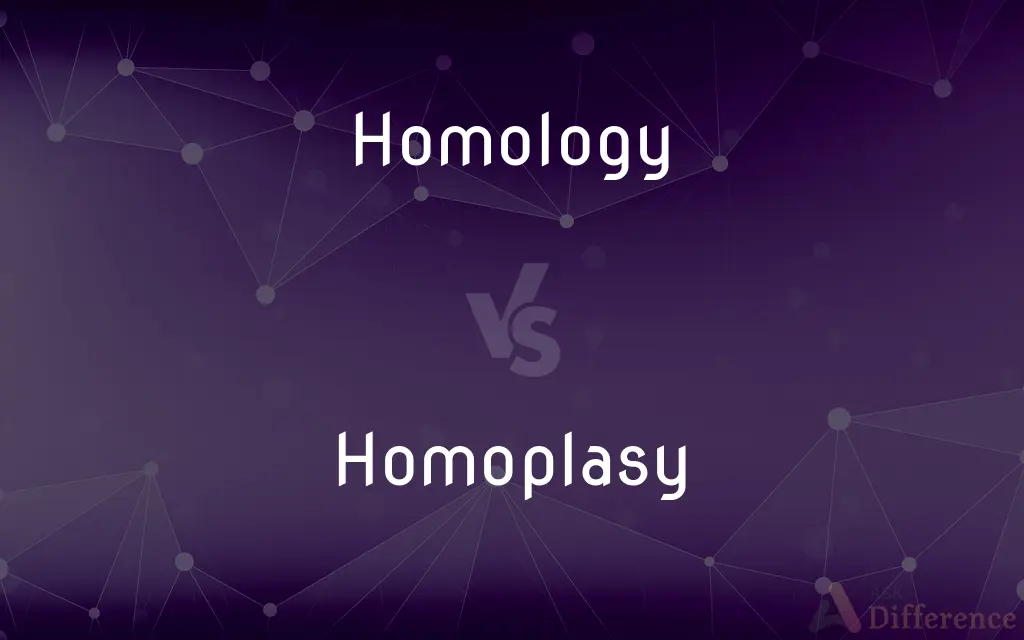Homology vs. Homoplasy — What's the Difference?
By Tayyaba Rehman — Updated on October 4, 2023
Homology refers to traits derived from a common ancestor, while homoplasy indicates traits with similar functions or appearances but different evolutionary origins. The former highlights ancestry, the latter convergence or parallelism.

Difference Between Homology and Homoplasy
Table of Contents
ADVERTISEMENT
Key Differences
Homology and homoplasy are critical concepts in evolutionary biology, helping to discern the origins and evolution of traits in organisms. Homology pertains to traits or characteristics in different species that have evolved from a shared ancestral trait. This shared ancestry means that even if the trait appears different in the two species, its origin is the same. For example, the bones in a human arm and a whale's flipper are homologous, as they both originate from a common tetrapod ancestor, even though their functions differ.
In contrast, homoplasy deals with similar traits or features in different species that have not arisen from common ancestry. Instead, these similarities have evolved independently, often as a response to similar environmental pressures or challenges. A classic example of homoplasy is the wings of bats and birds. While both have wings that function for flight, they did not inherit this trait from a common winged ancestor.
Furthermore, the emergence of homologous features is rooted in genetic inheritance from a common ancestor. This inheritance can lead to similarities across different species, reinforcing the idea of shared evolutionary history. On the flip side, homoplasy, which can result from convergent evolution or parallel evolution, emphasizes the adaptability of life. Organisms, even if unrelated, can develop analogous solutions when faced with similar ecological challenges.
Summarizing, while both homology and homoplasy deal with similarities in traits across species, their causes diverge. Homology reflects common ancestry and shared genetic inheritance, whereas homoplasy showcases the adaptive nature of evolution, where unrelated organisms independently evolve similar traits due to similar environmental pressures.
Comparison Chart
Definition
Traits derived from a common ancestor
Traits with similar functions but different origins
ADVERTISEMENT
Evolutionary Origin
Common ancestry
Independent evolution
Causes
Genetic inheritance from a common ancestor
Convergent or parallel evolution
Examples
Human arm bones and whale flipper bones
Wings of bats and birds
Significance
Emphasizes shared evolutionary history
Highlights adaptability and response to environmental cues
Compare with Definitions
Homology
Traits in organisms derived from a shared ancestor.
The vertebrate structure in fish and mammals is a result of homology.
Homoplasy
Traits in organisms that appear similar but have different evolutionary origins.
The fins of sharks and dolphins are examples of homoplasy.
Homology
Features retained from a shared ancestor.
The pentadactyl limb pattern is a homology among tetrapods.
Homoplasy
Similarities due to convergent or parallel evolution.
Cactus spines in the Americas and African Euphorbias demonstrate homoplasy.
Homology
Similarities due to shared evolutionary history.
The forelimbs of cats and bats show homology.
Homoplasy
Independent evolution of a feature in different lineages.
The ability to fly in insects and birds is a result of homoplasy.
Homology
Genetic inheritance from a common evolutionary precursor.
Homology can be observed in the genetic sequences of chimps and humans.
Homoplasy
Evolutionary mimicry not rooted in shared ancestry.
The eye patterns in some butterfly species exhibit homoplasy.
Homology
The quality or condition of being homologous.
Homoplasy
Traits evolved due to similar environmental challenges, not ancestry.
The streamlined bodies of dolphins and ichthyosaurs show homoplasy.
Homology
A homologous relationship or correspondence.
Homoplasy
Homoplasy, in biology and phylogenetics, is when a trait has been gained or lost independently in separate lineages over the course of evolution. This is different from homology, which is the similarity of traits can be parsimoniously explained by common ancestry.
Homology
The relation of the elements of a periodic family or group.
Homoplasy
Correspondence between parts or organs arising from evolutionary convergence.
Homology
The relation of the organic compounds forming a homologous series.
Homoplasy
(evolutionary theory) A correspondence between the parts or organs of different species acquired as the result of parallel evolution or convergence.
Homology
(Mathematics) A topological classification of configurations into distinct types that imposes an algebraic structure or hierarchy on families of geometric figures.
Homoplasy
See Homogeny.
Homology
The relationship of being homologous; a homologous relationship;
specifically, such relationship in the context of the geometry of perspective.
specifically, such relationship in the context of the geometry of perspective.
Homology
An automorphism of the projective plane (representing a perspective projection) that leaves all the points of some straight line (the homology axis) fixed and maps all the lines through some single point (the homology centre) onto themselves.
If the homology centre lies on the homology axis, the homology is said to be singular or parabolic; otherwise, it is called non-singular or hyperbolic.
Homology
A general way of associating a sequence of algebraic objects, such as abelian groups or modules, to a sequence of topological spaces; also used attributively: see Usage notes below.
Homology
(algebra) Given a chain complex {Gn} and its associated set of homomorphisms {Hn}, the rule which explains how each Hn maps Gn into the kernel of Gn+1.
Because of their connection with both homology and cohomology, chain complexes are an important topic of study in homological algebra.
Homology
(chemistry) The relationship, between elements, of being in the same group of the periodic table.
Homology
(organic chemistry) The relationship, between organic compounds, of being in the same homologous series.
Homology
The relationship, between characteristics or behaviours, of having a shared evolutionary or developmental origin;
(evolutionary theory) specifically, a correspondence between structures in separate life forms having a common evolutionary origin, such as that between flippers and hands.
(evolutionary theory) specifically, a correspondence between structures in separate life forms having a common evolutionary origin, such as that between flippers and hands.
Homology
(genetics) The presence of the same series of bases in different but related genes.
Homology
(anthropology) The relationship, between temporally separated human beliefs, practices or artefacts, of possessing shared characteristics attributed to genetic or historical links to a common ancestor.
Homology
The quality of being homologous; correspondence; relation; as, the homologyof similar polygons.
Homology
Correspondence or relation in type of structure in contradistinction to similarity of function; as, the relation in structure between the leg and arm of a man; or that between the arm of a man, the fore leg of a horse, the wing of a bird, and the fin of a fish, all these organs being modifications of one type of structure.
Homology
The correspondence or resemblance of substances belonging to the same type or series; a similarity of composition varying by a small, regular difference, and usually attended by a regular variation in physical properties; as, there is an homology between methane, CH4, ethane, C2H6, propane, C3H8, etc., all members of the paraffin series. In an extended sense, the term is applied to the relation between chemical elements of the same group; as, chlorine, bromine, and iodine are said to be in homology with each other. Cf. Heterology.
Homology
The quality of being similar or corresponding in position or value or structure or function
Homology
Evidence supporting evolutionary connections between species.
The similarity in mammalian ear bones is a case of homology.
Common Curiosities
Can homoplasy be mistaken for homology?
Yes, superficial similarities can sometimes lead to confusion between the two.
What causes homoplasy in organisms?
Homoplasy often results from convergent or parallel evolution due to similar environmental pressures.
Are homologous traits found only in closely related species?
No, they can be found in species that shared an ancestor long ago.
What is the primary difference between homology and homoplasy?
Homology refers to traits from a common ancestor, while homoplasy indicates independently evolved traits.
How can one determine if a trait is a result of homology or homoplasy?
Genetic studies, fossil records, and detailed morphological comparisons can help differentiate them.
Is molecular homology more accurate than morphological homology?
Molecular homology can offer more precise evolutionary insights, but both have their importance.
Why study homology in evolutionary biology?
Studying homology provides insights into evolutionary history and the diversification of life.
Are homologous structures always identical in appearance?
No, they can look different but share a common evolutionary origin.
Is homoplasy always due to convergent evolution?
Mostly, but it can also arise from parallel evolution.
Why is homology significant in evolutionary studies?
Homology helps identify shared ancestry and evolutionary relationships between species.
Can a trait be both homologous and homoplastic?
Rarely, but certain traits can have aspects that are both inherited and independently evolved.
Why does homoplasy occur?
Homoplasy occurs as unrelated organisms adapt to similar environments or challenges.
Can behaviors be homologous or homoplastic?
Yes, behaviors can also show patterns of homology or homoplasy.
How does parallel evolution differ from convergent evolution in homoplasy?
Parallel evolution involves similar changes in related lineages, while convergent evolution occurs in unrelated lineages.
Share Your Discovery

Previous Comparison
Cubicle vs. Cubical
Next Comparison
Accordantly vs. AccordinglyAuthor Spotlight
Written by
Tayyaba RehmanTayyaba Rehman is a distinguished writer, currently serving as a primary contributor to askdifference.com. As a researcher in semantics and etymology, Tayyaba's passion for the complexity of languages and their distinctions has found a perfect home on the platform. Tayyaba delves into the intricacies of language, distinguishing between commonly confused words and phrases, thereby providing clarity for readers worldwide.














































